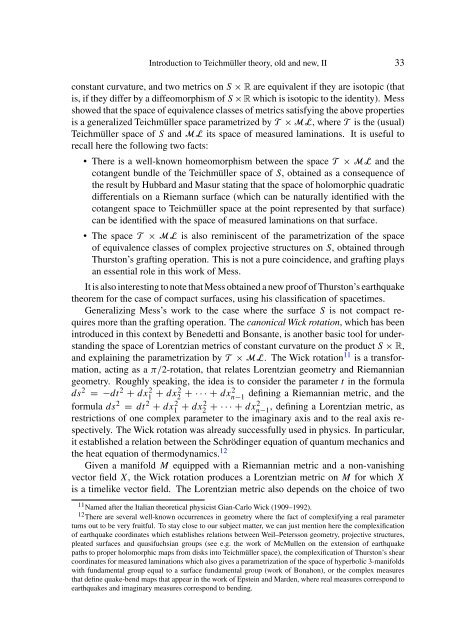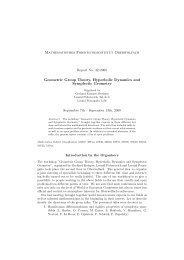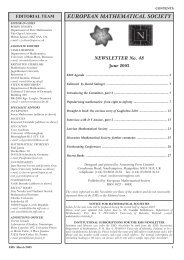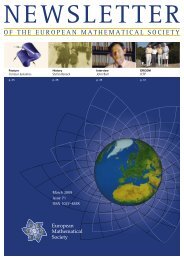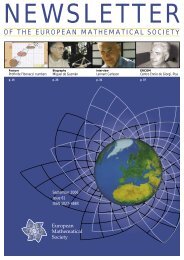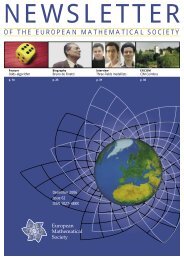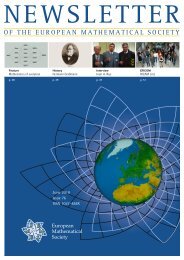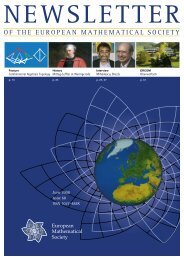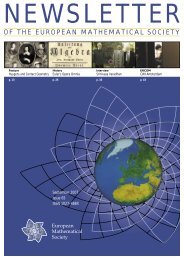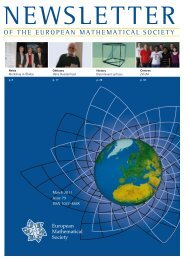Introduction to Teichmüller theory, old and new, II
Introduction to Teichmüller theory, old and new, II
Introduction to Teichmüller theory, old and new, II
Create successful ePaper yourself
Turn your PDF publications into a flip-book with our unique Google optimized e-Paper software.
<strong>Introduction</strong> <strong>to</strong> <strong>Teichmüller</strong> <strong>theory</strong>, <strong>old</strong> <strong>and</strong> <strong>new</strong>, <strong>II</strong> 33<br />
constant curvature, <strong>and</strong> two metrics on S × R are equivalent if they are iso<strong>to</strong>pic (that<br />
is, if they differ by a diffeomorphism of S × R which is iso<strong>to</strong>pic <strong>to</strong> the identity). Mess<br />
showed that the space of equivalence classes of metrics satisfying the above properties<br />
is a generalized <strong>Teichmüller</strong> space parametrized by T × ML, where T is the (usual)<br />
<strong>Teichmüller</strong> space of S <strong>and</strong> ML its space of measured laminations. It is useful <strong>to</strong><br />
recall here the following two facts:<br />
There is a well-known homeomorphism between the space T × ML <strong>and</strong> the<br />
cotangent bundle of the <strong>Teichmüller</strong> space of S, obtained as a consequence of<br />
the result by Hubbard <strong>and</strong> Masur stating that the space of holomorphic quadratic<br />
differentials on a Riemann surface (which can be naturally identified with the<br />
cotangent space <strong>to</strong> <strong>Teichmüller</strong> space at the point represented by that surface)<br />
can be identified with the space of measured laminations on that surface.<br />
The space T × ML is also reminiscent of the parametrization of the space<br />
of equivalence classes of complex projective structures on S, obtained through<br />
Thurs<strong>to</strong>n’s grafting operation. This is not a pure coincidence, <strong>and</strong> grafting plays<br />
an essential role in this work of Mess.<br />
It is also interesting <strong>to</strong> note that Mess obtained a <strong>new</strong> proof of Thurs<strong>to</strong>n’s earthquake<br />
theorem for the case of compact surfaces, using his classification of spacetimes.<br />
Generalizing Mess’s work <strong>to</strong> the case where the surface S is not compact requires<br />
more than the grafting operation. The canonical Wick rotation, which has been<br />
introduced in this context by Benedetti <strong>and</strong> Bonsante, is another basic <strong>to</strong>ol for underst<strong>and</strong>ing<br />
the space of Lorentzian metrics of constant curvature on the product S × R,<br />
<strong>and</strong> explaining the parametrization by T × ML. The Wick rotation11 is a transformation,<br />
acting as a π/2-rotation, that relates Lorentzian geometry <strong>and</strong> Riemannian<br />
geometry. Roughly speaking, the idea is <strong>to</strong> consider the parameter t in the formula<br />
ds2 =−dt2 + dx2 1 + dx2 2 + ··· + dx2 n−1 defining a Riemannian metric, <strong>and</strong> the<br />
formula ds2 = dt2 + dx2 1 + dx2 2 +···+dx2 n−1 , defining a Lorentzian metric, as<br />
restrictions of one complex parameter <strong>to</strong> the imaginary axis <strong>and</strong> <strong>to</strong> the real axis respectively.<br />
The Wick rotation was already successfully used in physics. In particular,<br />
it established a relation between the Schrödinger equation of quantum mechanics <strong>and</strong><br />
the heat equation of thermodynamics. 12<br />
Given a manif<strong>old</strong> M equipped with a Riemannian metric <strong>and</strong> a non-vanishing<br />
vec<strong>to</strong>r field X, the Wick rotation produces a Lorentzian metric on M for which X<br />
is a timelike vec<strong>to</strong>r field. The Lorentzian metric also depends on the choice of two<br />
11 Named after the Italian theoretical physicist Gian-Carlo Wick (1909–1992).<br />
12 There are several well-known occurrences in geometry where the fact of complexifying a real parameter<br />
turns out <strong>to</strong> be very fruitful. To stay close <strong>to</strong> our subject matter, we can just mention here the complexification<br />
of earthquake coordinates which establishes relations between Weil–Petersson geometry, projective structures,<br />
pleated surfaces <strong>and</strong> quasifuchsian groups (see e.g. the work of McMullen on the extension of earthquake<br />
paths <strong>to</strong> proper holomorphic maps from disks in<strong>to</strong> <strong>Teichmüller</strong> space), the complexification of Thurs<strong>to</strong>n’s shear<br />
coordinates for measured laminations which also gives a parametrization of the space of hyperbolic 3-manif<strong>old</strong>s<br />
with fundamental group equal <strong>to</strong> a surface fundamental group (work of Bonahon), or the complex measures<br />
that define quake-bend maps that appear in the work of Epstein <strong>and</strong> Marden, where real measures correspond <strong>to</strong><br />
earthquakes <strong>and</strong> imaginary measures correspond <strong>to</strong> bending.


